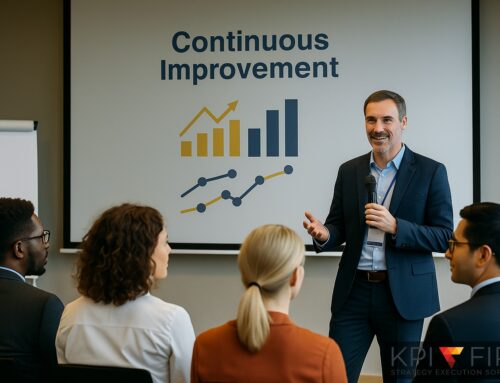In today’s rapidly evolving business landscape, standing still is akin to falling behind. The ability to continuously improve operations, products, and services is no longer a competitive advantage, but a fundamental requirement for survival and success. This article delves into the world of Continuous Improvement (CI), exploring its core methodologies and best practices. Whether you’re a seasoned executive, a dedicated project manager, or a team member eager to contribute to organizational growth, this guide will equip you with the knowledge and tools to drive meaningful change. KPI Fire’s Continuous Improvement Software is highlighted in conlusion as the ideal CI management system for organizations.
Main Takeaways from This Article
- Continuous Improvement (CI) is essential for business survival: In today’s competitive market, businesses must constantly improve their operations, products, and services to remain successful.
- CI offers numerous benefits: These include enhanced efficiency, reduced costs, improved quality, increased customer satisfaction, greater employee engagement, and a competitive advantage.
- Key methodologies for CI include: Plan-Do-Check-Act (PDCA), Six Sigma, Lean, Root Cause Analysis, Kaizen, and Total Quality Management (TQM).
- Successful CI implementation requires: Clear and measurable goals, a supportive culture, employee engagement, incremental changes, and data-driven decision-making.
- Continuous Improvement Software like KPI Fire can streamline the process by facilitating goal setting, tracking progress, fostering collaboration, and providing valuable insights.
What is Continuous Improvement?
Continuous Improvement is a philosophy that emphasizes the ongoing pursuit of incremental improvements in all aspects of an organization. It involves a systematic and disciplined approach to identifying and eliminating waste, reducing errors, and enhancing efficiency in processes, products, and services. By fostering a culture of continuous learning and adaptation, organizations can improve their overall performance, increase customer satisfaction, and gain a competitive edge in the ever-changing market.
The Benefits of Continuous Improvement
Continuous Process Improvement (CPI) brings tangible advantages to businesses across various industries. By consistently refining their operations, organizations can unlock significant benefits that impact their bottom line and overall success.
Here are some key advantages of implementing CPI:
Enhanced Operational Efficiency
Continuous process improvement streamlines workflows by identifying and eliminating redundant steps, optimizing resource allocation, and reducing bottlenecks. This leads to faster operations, improved productivity, and a reduction of the 8 wastes.
Cost Reduction
Continuous / Lean process improvement drives cost reduction by eliminating waste and optimizing resource management. By streamlining workflows, reducing errors, and minimizing rework, businesses can significantly lower operating expenses. Incremental improvements made over time contribute to substantial cost savings across various departments.
Improved Quality and Service Quality
Continuous improvement drives consistent evaluation and refinement of processes, leading to higher product and service standards. By minimizing errors and enhancing reliability, businesses deliver superior products and services that exceed customer expectations. This improved quality strengthens customer trust and loyalty, fostering long-term relationships.
Increased Customer Satisfaction
Continuous process improvement results in more efficient service delivery and higher product quality, consistently meeting or exceeding customer expectations. By improving the value you bring to customers, satisfied customers are more likely to remain loyal to the business, repeat purchases, and recommend the company to others, leading to increased market share and revenue growth.
Greater Employee Engagement and Morale
Involving employees in improvement initiatives fosters a sense of ownership and motivation. When employees actively contribute to positive changes within the organization, they feel valued and engaged, leading to improved morale and a more positive work environment.
Competitive Advantage
Organizations practicing continuous improvement are better equipped to adapt quickly to market changes and stay ahead of competitors. Consistent enhancements lead to better quality, cost savings, and faster response times, giving the company a significant competitive edge in the marketplace.
Continuous Improvement Process Methodologies
Several powerful methodologies guide organizations on their journey of continuous improvement. These techniques provide structured frameworks and tools to identify areas for enhancement, analyze root causes of problems, and implement sustainable solutions. By embracing these methodologies, organizations can foster a culture of ongoing improvement and achieve operational excellence.
1. Plan-Do-Check-Act (PDCA) Cycle
The PDCA Cycle, also known as the Deming Cycle, is an iterative problem-solving and process improvement methodology. It involves four key stages: Plan, Do, Check, and Act. By systematically following these steps, organizations can identify areas for improvement, implement solutions, analyze the results, and make adjustments for continuous enhancement.
2. Six Sigma Methodology
Six Sigma is a data-driven methodology focused on reducing defects and improving processes. It utilizes a structured approach called DMAIC (Define, Measure, Analyze, Improve, and Control) to identify and eliminate the root causes of variation within a process. By employing statistical tools and techniques, Six Sigma aims to achieve near-perfect levels of quality and efficiency.
3. Lean Methodology
The Lean methodology focuses on identifying and eliminating waste (muda) in all forms, including overproduction, waiting, transportation, inventory, motion, defects, and over-processing. Lean principles, such as value stream mapping and Kanban boards, help streamline processes, reduce lead times, and improve overall efficiency.
4. Root Cause Analysis
Root Cause Analysis (RCA) is a critical tool for identifying the underlying causes of problems within a process. Techniques such as the 5 Whys and fishbone diagrams help to systematically delve deeper beyond surface-level issues, uncovering the root causes that contribute to inefficiencies, defects, and other negative outcomes. By addressing these root causes, organizations can implement effective and sustainable solutions.
5. Kaizen
Kaizen, a Japanese term meaning “continuous improvement,” emphasizes the importance of small, incremental changes made by all employees. By encouraging daily participation and focusing on small, ongoing improvements, Kaizen fosters a culture of continuous improvement where everyone contributes to enhancing processes and achieving operational excellence.
6. Total Quality Management (TQM)
TQM is a comprehensive approach to organizational management that focuses on continuous quality improvement across all aspects of the business. TQM emphasizes customer satisfaction, employee involvement, and data-driven decision making to achieve long-term success. By aligning company culture with quality goals, TQM fosters a culture of excellence and drives sustainable improvements in performance.
7. Continuous Improvement Software Tools
Continuous improvement software tools like KPI Fire empowers organizations to effectively track progress, manage improvement projects, and support data-driven decision-making. These tools facilitate collaboration among project teams, streamline improvement processes, and provide valuable insights to drive sustainable organizational growth.
8. Employee Training and Engagement Programs
Adequate training and active employee engagement are crucial for successful continuous improvement implementations. Training equips team members with the necessary knowledge, skills, and tools to identify areas for improvement, contribute new ideas, and effectively participate in improvement projects. Engaged employees are more likely to embrace change, actively seek opportunities for improvement, and contribute to a culture of continuous learning and growth.
Implementing Continuous Improvement Processes: Best Practices
Successfully implementing continuous improvement requires a structured approach and a commitment to following best practices. By adhering to these principles, organizations can maximize the benefits of their improvement efforts, ensure sustainable results, and foster a culture of continuous learning and growth.
1. Establish Clear and Measurable Goals
Establishing clear and measurable goals is crucial for successful continuous improvement initiatives. Specific, quantifiable, achievable, relevant, and time-bound (SMART) goals provide a clear direction for improvement efforts, enabling organizations to track progress effectively and ensure that improvement activities are aligned with overall business objectives.
2. Foster a Continuous Improvement Culture
Creating a culture that values continuous improvement is essential for sustained participation and support. This requires consistent communication, employee recognition, and active leadership involvement. Leaders must model desired behaviors, champion improvement initiatives, and demonstrate their commitment to continuous learning and growth.
3. Engage Employees at All Levels
Engaging employees at all levels brings diverse insights and fosters collaboration. By providing training and empowering employees to contribute to improvement initiatives, organizations can tap into a wealth of knowledge and expertise, leading to more creative and effective solutions.
4. Implement Incremental Changes
Implementing incremental changes is more effective than attempting large-scale overhauls. Small, manageable changes can be easily tested, refined, and adjusted based on the results. Iterative approaches like the PDCA cycle provide a structured framework for implementing these changes step-by-step, ensuring continuous learning and improvement.
5. Leverage Data for Informed Decision-Making
Leveraging data is crucial for informed decision-making in continuous improvement. Data helps identify opportunities for improvement, guide decisions based on evidence, and validate the impact of implemented changes. Methodologies like Six Sigma emphasize the use of data-driven analysis and performance tracking to ensure that improvements are sustainable and deliver meaningful results.
Drive Continuous Improvement with KPI Fire
In today’s dynamic business landscape, continuous improvement is no longer optional, it’s essential. By systematically refining your processes, you can unlock significant advantages that impact your bottom line and overall success.
This guide has explored various methodologies and best practices for implementing continuous improvement. From establishing clear goals and fostering a culture of innovation to leveraging data and empowering employees, these strategies can equip your organization to achieve operational excellence.
Ready to ignite your continuous improvement journey?
KPI Fire is a powerful platform designed to help you implement these methodologies effectively. With KPI Fire, you can:
- Set SMART goals and track progress to ensure your improvement initiatives are aligned with your business objectives.
- Foster a culture of continuous improvement by creating a platform for collaboration, communication, and employee recognition.
- Leverage data for informed decision-making with robust analytics and reporting tools.
- Empower employees at all levels to contribute their ideas and expertise.
See for yourself how KPI Fire can help you achieve operational excellence. Request a free demo today!




